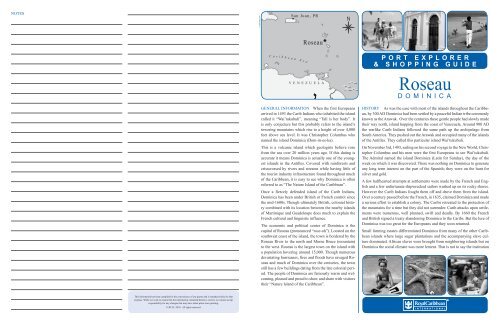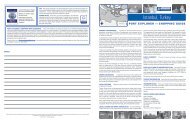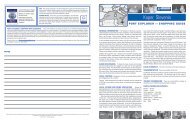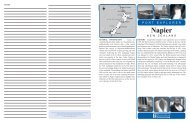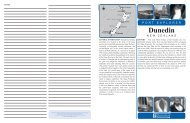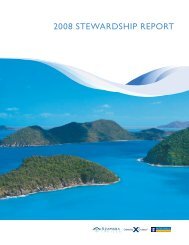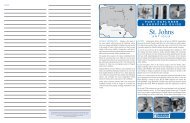Roseau
Roseau - Royal Caribbean
Roseau - Royal Caribbean
- No tags were found...
Create successful ePaper yourself
Turn your PDF publications into a flip-book with our unique Google optimized e-Paper software.
NOTES<br />
© 2010 maps.com<br />
San Juan, PR<br />
<strong>Roseau</strong><br />
C<br />
a r i b<br />
b e a n S<br />
e a<br />
V E N E Z U E L A<br />
GENERAL INFORMATION When the first Europeans<br />
arrived in 1493 the Carib Indians who inhabited the island<br />
called it “Wai’tukubuli”, meaning “Tall is her body”. It<br />
is only conjecture but this probably refers to the island’s<br />
towering mountains which rise to a height of over 4,000<br />
feet above sea level. It was Christopher Columbus who<br />
named the island Dominica (Dom-in-ee-ka).<br />
This is a volcanic island which geologists believe rose<br />
from the sea over 20 million years ago. If this dating is<br />
accurate it means Dominica is actually one of the youngest<br />
islands in the Antilles. Covered with rainforests and<br />
crisscrossed by rivers and streams while having little of<br />
the tourist industry infrastructure found throughout much<br />
of the Caribbean, it is easy to see why Dominica is often<br />
referred to as “The Nature Island of the Caribbean”.<br />
Once a fiercely defended island of the Carib Indians,<br />
Dominica has been under British or French control since<br />
the mid-1600s. Though ultimately British, colonial history<br />
combined with its location between the nearby islands<br />
of Martinique and Guadeloupe does much to explain the<br />
French cultural and linguistic influence.<br />
The economic and political center of Dominica is the<br />
capital of <strong>Roseau</strong> (pronounced “rose-oh”). Located on the<br />
southwest coast of the island, the town is bordered by the<br />
<strong>Roseau</strong> River to the north and Morne Bruce (mountain)<br />
to the west. <strong>Roseau</strong> is the largest town on the island with<br />
a population hovering around 15,000. Though numerous<br />
devastating hurricanes, fires and floods have ravaged <strong>Roseau</strong><br />
and much of Dominica over the centuries, the town<br />
still has a few buildings dating from the late colonial period.<br />
The people of Dominica are famously warm and welcoming,<br />
pleased and proud to show and share with visitors<br />
their “Nature Island of the Caribbean”.<br />
PORT EXPLORER<br />
& SHOPPING GUIDE<br />
<strong>Roseau</strong><br />
DOMINICA<br />
History As was the case with most of the islands throughout the Caribbean,<br />
by 300 AD Dominica had been settled by a peaceful Indian tribe commonly<br />
known as the Arawak. Over the centuries these gentle people had slowly made<br />
their way north, island hopping from the coast of Venezuela. Around 900 AD<br />
the warlike Carib Indians followed the same path up the archipelago from<br />
South America. They pushed out the Arawak and occupied many of the islands<br />
of the Antilles. They called this particular island Wai’tukubuli.<br />
On November 3rd, 1493, sailing on his second voyage to the New World, Christopher<br />
Columbus and his men were the first Europeans to see Wai’tukubuli.<br />
The Admiral named the island Dominica (Latin for Sunday), the day of the<br />
week on which it was discovered. There was nothing on Dominica to generate<br />
any long term interest on the part of the Spanish; they were on the hunt for<br />
silver and gold.<br />
A few halfhearted attempts at settlements were made by the French and English<br />
and a few unfortunate shipwrecked sailors washed up on its rocky shores.<br />
However the Carib Indians fought them off and drove them from the island.<br />
Over a century passed before the French, in 1635, claimed Dominica and made<br />
a serious effort to establish a colony. The Caribs retreated to the protection of<br />
the mountains for a time but they did not surrender. Carib attacks upon settlements<br />
were numerous, well planned, swift and deadly. By 1660 the French<br />
and British signed a treaty abandoning Dominica to the Caribs. But the lure of<br />
Dominica was too great for the Europeans and they soon returned.<br />
Small farming estates differentiated Dominica from many of the other Caribbean<br />
islands where large sugar plantations and the accompanying slave culture<br />
dominated. African slaves were brought from neighboring islands but on<br />
Dominica the social climate was more lenient. That is not to say the institution<br />
This information has been compiled for the convenience of our guests and is intended solely for that<br />
purpose. While we work to ensure that the information contained herein is correct, we cannot accept<br />
responsibility for any changes that may have taken place since printing.<br />
© RCCL 2010. All rights reserved.
of slavery was enjoyed by those in bondage. However, on Dominica<br />
slaves were allowed to grow their own gardens and raise farm animals.<br />
This led to the creation of markets where some slaves were eventually<br />
able to earn enough to buy their freedom. Yet the life of slavery remained<br />
a terrible burden.<br />
Hurricanes brought privation as crops were destroyed. The otherwise<br />
intolerable conditions combined to foster numerous slave revolts and<br />
uprisings. Those slaves who managed to escape their masters headed<br />
for the mountains, the jungle fortress of the Caribs. Over time so many<br />
slaves escaped that entire villages and communities sprang up across<br />
the island, hidden away. The runaways were known as the Maroons.<br />
In 1763 Dominica officially became a British possession and the Maroons<br />
were defeated. Slavery was not abolished on the island until<br />
1834.<br />
7 8<br />
1-3 4 5 6<br />
But what became of Dominica’s Carib Indians? Preferring death to<br />
slavery throughout the Caribbean, as a people, the Caribs were virtually<br />
wiped out. Many Caribs also perished from European disease,<br />
against which they had no natural immunity. Today, greatly intermingled<br />
with the bloodlines of the former African slaves, in an area of<br />
eastern Dominica known as the Carib Territory there are believed to<br />
be the only remaining direct descendents of Caribs to be found anywhere<br />
in the Antilles. Numbering approximately 3,000, they are free<br />
to live according to their cultural traditions.<br />
On November 3rd 1978, 485 years (to the day) after Christopher<br />
Columbus set eyes upon the island, the people gained their freedom<br />
from English colonial rule. Dominica became an independent republic<br />
within the British Commonwealth.<br />
9<br />
© 2010 maps.com<br />
© 2010 maps.com<br />
Morne Bruce is a hill overlooking the Botanical Garden and town.<br />
3 It is a popular site for visitors to pull out their cameras. The lookout<br />
can be reached by car or a path leading up from the Botanical<br />
Garden.<br />
Beyond <strong>Roseau</strong><br />
4<br />
Morne Trois Pitons National Park is a mountainous setting in<br />
the rainforest filled with waterfalls, amazing plants and birds,<br />
hot springs and volcanoes. Hiking paths allow visitors to reach the<br />
famous Boiling Lake. This natural treasure is a UNESCO World Heritage<br />
Site.<br />
5<br />
Wotten Waven Sulphur Springs are another example of the island’s<br />
volcanic activity. Some of the hot springs have man-made<br />
stone pools which allow visitors the opportunity to soak in the thermal<br />
baths.<br />
6<br />
Ti Tou Gorge is an amazing site in the gap of a mountain. There<br />
are hot and cold streams and pools which are great for swimming<br />
or soaking.<br />
7<br />
Trafalgar Falls and the Emerald Pool are beautiful twin waterfalls.<br />
There is a nice observation deck to take in the views while<br />
fellow visitors take advantage of the refreshing natural pools to enjoy<br />
a swim.<br />
8<br />
The Layou River is the island’s largest. Tubes and knowledgeable<br />
guides are available to take visitors on an easy ride through<br />
some of the most beautiful scenery on Dominica.<br />
9<br />
Kalinago Barana Aute (Carib Model Village) shares with visitors<br />
the arts and crafts, dance, customs and heritage of the ancient<br />
Carib Indians. Located in what is known as the Carib Territory, the<br />
Kalinago are believed to be the last surviving descendents of the Carib<br />
Indians who formerly populated many of the islands of the Antilles.<br />
Shore Excursions To make the most of your visit to <strong>Roseau</strong><br />
and the surrounding area we suggest you take one of our organized<br />
Shore Excursions. For information concerning tour content and pricing,<br />
consult your Shore Excursion Brochure or contact the Shore Excursion<br />
Desk.<br />
Local Customs<br />
vendors may bargain.<br />
Bargaining: Prices are generally fixed. Local<br />
Tipping: Some restaurants may add a 10-15% service charge. The<br />
same percentage is appropriate for taxis.<br />
Red Cap, Soca and Macoucherie are popular rums produced on Dominica.<br />
Macoucherie is said to be the only island rum distilled from locally<br />
grown sugarcane.<br />
Shopping The Old Market Plaza is close to the pier. This was the<br />
site of the slave market during the colonial era. Items of local interest<br />
include leather goods, woven baskets, island rum, lace and wood carvings.<br />
Some shops in the area offer the works of local artists.<br />
Local Currency The official currency on Dominica is the<br />
East Caribbean dollar. U.S. dollars and major credit cards are widely<br />
accepted.<br />
Post Office and Telephone Facilities The main Post<br />
Office is located across from the ferry terminal on Bayfront.<br />
Dial the following access numbers to use a personal calling card from<br />
a public phone:<br />
AT&T: 1.800.225.5288<br />
MCI: 1.800.888.8000<br />
Tourist Information The Tourist Information Center is located<br />
directly opposite the <strong>Roseau</strong> Cruise Ship Berth downstairs from<br />
the Museum on the Bayfront.<br />
Transportation Rental cars and taxis are available. Determine<br />
a fare prior to departure.<br />
Language English is the official language of Dominica. French<br />
based Créole, also known as Patois, is spoken by many of the islanders.<br />
rOSEAU PLACEs of Interest<br />
1<br />
The Dominica Museum offers visitors insight into the island’s<br />
history from its geologic creation through the early Carib Indians,<br />
European discovery and colonization and on to 20th century independence.<br />
PLACES OF INTEREST<br />
2<br />
The Botanical Garden was established in 1890. This is a beautiful<br />
setting consisting of over 150 different species of tropical<br />
flowers, plants and trees, many of them quite rare. The garden underwent<br />
slow and extensive renovation following Hurricane David (category<br />
5) which mercilessly ravaged <strong>Roseau</strong> and Dominica in 1979.<br />
Local Cuisine and Drink Specialties As is common<br />
throughout the many islands of the Caribbean the cuisine of Dominica<br />
is a combination of traditional West Indian, French and West African.<br />
Chicken Stew is a dish where the chicken is marinated with chilies,<br />
lemon juice, garlic and vinegar then added to sautéed garlic, thyme,<br />
coriander and onions. Vegetables, Créole sauce and water are added<br />
then covered and simmered. It is often served on a bed of white rice.<br />
Boiled Crabs are often prepared by sautéing onions and adding a mixture<br />
of coconut milk, thyme, garlic and curry powder with water and<br />
bring it all to a boil. Curried Goat is stewed with a mixture of onions,<br />
tomatoes, garlic, carrots and curry powder. Creole Banana Cake is a<br />
favorite desert which combines flour, eggs, bananas, cinnamon, vanilla,<br />
cream and lemon juice.


